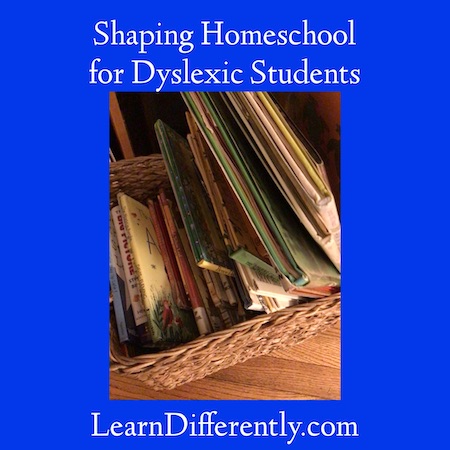Shaping homeschool for dyslexic students

by Kathy Kuhl This week, a mother wrote:
Hi Kathy, I am homeschooling my five kids. We have found out that our oldest (9 years old) has dyslexia. And I have realized that I have also have dyslexia. I have been doing the Barton tutoring with him. Which has helped a ton! But I am trying to figure out if I need to do another whole curriculum or if there’s anything else I can be doing to help him? Thank you!
I told her I’m glad Barton is helping, and started to reply. Some of you may have similar questions. So I here’s what I wrote.

Reading Curriculum for Dyslexics
Some people have less severe dyslexia. Some learn from any good Orton-Gillingham based curriculum, such as The Struggling Reader, A Reason for Reading, All About Reading, or Diana Hanbury King’s little book.
Other people need more explicit instruction, like you’re providing your kids by training yourself using Sue Barton’s videos.
There’s a third group of dyslexics who need an expert, someone who’s been supervised and developed techniques and experience that no one can give via video. These students need an expert in teaching dyslexics to read. I wrote about finding those experts here. (Those experts help with all aspects of dyslexia, though that post focuses on fluency and comprehension.) For Orton-Gillingham structured literacy therapy online, check out Lexercise.*
Perhaps your child needs more help than you can give, even with your Barton training. Also, some dyslexics are what Drs. Brock and Fernette Eide of Dyslexic Advantage and the Eide Neurolearning Clinic call “stealth dyslexics.” These dyslexics can learn to decode (that is, to sound out words), but reading remains exhausting. So they don’t read fluently. Reading is so exhausting they lack the mental energy to visualize what their reading. Those students need that more explicit, systematic instruction. When such an expert breaks the rules down minutely and provides many language and mnemonic techniques, many people can learn to read who thought they never would.
Beyond reading curriculum for dyslexics,
you should also consider the rest of your language arts instruction. Many of the programs listed above have related writing and vocabulary components. If possible, use materials that coordinate with your reading curriculum. It’s easier on students to have similar terminology and approaches for reading, writing, and spelling.
Despite dyslexia, your child may be a great writer, so don’t neglect writing. Did you know many successful writers are dyslexic? The part of the brain that decodes is not the part that creates compelling stories. Many successful writers and storytellers–from Faulkner to Dav Pilkey (I’m a big fan of his Dragon books), Fannie Flagg, and Steven Spielberg–struggled with reading or spelling, but know how to tell a great story.
If you need to supplement your instruction in language arts, here are some favorites:
- William Van Cleave’s many materials on teaching writing go well with any Orton-G based program.
- Spelling Power
- SpellingCity.com
- Frode Jensen’s Format Writing. In our homeschool group, my students loved that they could pick their topics.
- Winston Grammar (volume 1 is here),
- The Institute for Excellence in Writing, IEW, is popular. Several parents teaching kids with learning disabilities tell me they’ve liked it.
Beyond Language Arts
Your child’s dyslexia affects more than how you teach reading or English. Here’s some ways to adapt and improve your homeschool to help your dyslexic child thrive:
- Read aloud. Reading books aloud together helps your children enjoy stories as an experience they share with you. Sarah McKenzie’s Read Aloud Revival has great book lists and tips. Also, you may like her podcast.You use read aloud time to help build fluency—let them read along silently with you. Or alternate paragraphs.But read aloud as a family sometimes just for pleasure. Don’t stop reading when they learn to read. It’s good for your relationships, and for building vocabulary.
- Encourage reading for pleasure—at whatever level is easy for them. I love to read, but I don’t read philosophy or economics for pleasure. At the end of the day, (right now), I want to sit down with what I enjoy: literature or biography.For your child, it might be a magazine about skateboarding, horses, a book they first read when they were ten, a manga, a Rick Riordan book (Percy Jackson is a dyslexic demigod hero), or a book about starfish, or whatever they like. As they grow, skim them first or find a trusted website with reviews. Make sure the content is appropriate for your child’s age, maturity, and circumstances.
- Accommodations:
Recorded books, dictation software built into your devices.
Audio books in the car, ear buds.
Don’t’ say “it is not really reading.” Yes, it counts.
Pre-read or listen to plays before you study them.
Taking in books auditory helps dyslexics build vocabulary. That’s important because reading is the main way people build vocabulary. So dyslexic students typically get farther and farther behind their peers in vocabulary size. Audio books close the great gap - Alternative forms of presentations: Your child can give oral, visual, or material presentations instead of written ones. In Learning Outside the Lines, author ____ reveals that the college application essay that got him into Brown University was a sculpture.
For more information
on dyslexia and on crafting your homeschool to help dyslexics, see:
- Marianne Sunderland’s website, Homeschooling with Dyslexia.
- HSLDA Special Needs page (*Search for dyslexia. HSLDA members get a 40% discount on Lexercise! But there are many good reasons to join.)
- Learning Disabilities Association of America
- International Dyslexia Association

Don’t overfocus on your child’s dyslexia
Your child is not a diagnosis, but a person. Give them opportunities and tasks that build on their strengths and interests.
If you don’t see their strengths yet, don’t worry. (I didn’t at first, and worrying didn’t help!) Provide opportunities in many areas and give them responsibilities and encouragement and time. Get them off the computer, get them outside, get them helping others. Sooner or later, you’ll begin to see their strengths.
Enjoy your child.
I welcome your comments and suggestions below.


Dyslexics lack phonemic awareness. I recommend David Kilpatrick’s Equipped for Reading Success both to learn more about the auditory deficiency of dyslexics and how to fill the gap. Another resource that is open and go is Heggerty’s Bridge the Gap for intervention up to 2nd grade. There are resources for early pre-K, pre-K, Kindergarten, and first grades. Kilpatrick goes beyond 2nd and into 3rd and higher grade if desired.
No phonics program, even thoroughly structured literacy or Orton-Gillingham-based, is the line solution.
To borrow a term from chemistry, phonemic awareness is the limiting factor. It is the bottleneck and determinant of how much progress a student will make.
Dyslexics need to encode, orthographically map words multiple times to store them in their long term memory. If they do not have full alphabetic understanding, meaning they cannot correlate every sound, including the medial sounds, of a word to phonograms. They need to be able to isolate, segment, manipulate, and blend sounds automatically within 2 seconds.
This is the goal a dyslexic student needs to work on in parallel with a solid program like Barton.
I also recommending learning more about structured literacy and the science of reading. Another great source of learning for teachers and parents is Speech to Print.
Lisa, thanks for writing. I have not used Kilpatrick’s nor Heggerty’s materials, but I appreciate your comments and suggestions. I agree with you about the importance of isolating, segmenting, manipulating and blending sounds.
However, I would not describe an Orton-Gillingham (OG) program (aka Multisensory-Structured Language, MSL) as merely phonetic, based on my study of and observations of MSL techniques. (Granted, anyone can say their approach is O-G/MSL based. The IDA site has a list of good ones; see link above.) We agree phonemic awareness is critical. It’s part of MSL approaches. Other factors can contribute to dyslexia. As Marianne Wolf says in Proust and the Squid, many different brain regions contribute to reading. So difficulty in any of those regions can hinder reading. Happily, therapies can help.
Thanks again for your comment.